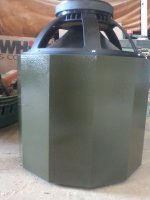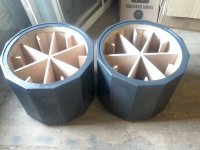Greets!
Somewhat, though unfortunately I've never been exposed to any measurements, math theory/whatever behind it, just when using the pioneer's spec drivers they always performed well by the standards of the day, so like to post it for historical completeness, so to speak. 😉
Pg. 76: https://archive.org/details/HowToBuildSpeakerEnclosuresByAlexixBadmaieffDonDavis/page/n75/mode/2up
“A nagging question in the design stage of any enclosure of this type is "How large shall it be?” It was pointed out earlier that the enclosure can be too large or too small for proper bass-reflex action. This implies that an optimum volume exists and indeed it does. This optimum volume does not depend upon the size of the speaker nor its resonant frequency per se but rather on the ratio of enclosure air stiffness to the speaker cone suspension stiffness. This optimum ratio is 1.44 or, looking at it another way, the speaker resonant frequency in the enclosure before porting should be 1.56 times the free-air resonance of the speaker. This size enclosure, when properly tuned, yields at the same time the most extended low-frequency response and a transient response with subjectively unnoticeable hangover, assuming sufficient damping exists. Compared to the entirely closed cabinet, the half-power point (3 db down) occurs at 0.7 times the closed cabinet speaker resonance for an extension of one-half octave."
Somewhat, though unfortunately I've never been exposed to any measurements, math theory/whatever behind it, just when using the pioneer's spec drivers they always performed well by the standards of the day, so like to post it for historical completeness, so to speak. 😉
Pg. 76: https://archive.org/details/HowToBuildSpeakerEnclosuresByAlexixBadmaieffDonDavis/page/n75/mode/2up
“A nagging question in the design stage of any enclosure of this type is "How large shall it be?” It was pointed out earlier that the enclosure can be too large or too small for proper bass-reflex action. This implies that an optimum volume exists and indeed it does. This optimum volume does not depend upon the size of the speaker nor its resonant frequency per se but rather on the ratio of enclosure air stiffness to the speaker cone suspension stiffness. This optimum ratio is 1.44 or, looking at it another way, the speaker resonant frequency in the enclosure before porting should be 1.56 times the free-air resonance of the speaker. This size enclosure, when properly tuned, yields at the same time the most extended low-frequency response and a transient response with subjectively unnoticeable hangover, assuming sufficient damping exists. Compared to the entirely closed cabinet, the half-power point (3 db down) occurs at 0.7 times the closed cabinet speaker resonance for an extension of one-half octave."
https://www.diyaudio.com/community/threads/my-double-bass-array-with-low-q-subs.392998/Look forward to hearing any experiences with these types of woofer/subwoofer setups.
And theoretical 😎 FR for four Qtc=0.0.. subs:
Last edited:
As a quick addendum to GM's post -Bass Box Pro has some interesting features compared to a few other cavity-resonance based calculators, notably its handy tools for quickly calculating approximate volume taken up by drivers, vents, bracing & the like, and rough dimensions for boxes of different shapes with a given internal volume. But its default assumptions for damping, leakage etc. values can sometimes be a bit different to what's used in other software packages, so for the most consistent results, I find it's best to go into its configuration options & adjust so they roughly match what some others use. Likewise, you need to add the series R mentioned for typical wire, connection, series inductor (where relevant) losses as this affects the end result due to the increased effective driver Q.
Even then -speaking purely for myself, I've found BB6Pro can throw up some odd volume and tuning results, sometimes significantly at variance from those calculated via other means, be it software or manual number-crunching. Not all the time, and often there's very little in it. But I've certainly found quite a few surprising results with both vented and sealed alignments, either in terms of it suggesting a (usually) smaller cabinet volume, and / or a higher tuning than identical data entry & alignments obtained from alternatives. I've never got to the bottom of why though. When I first discovered what seemed to me a strange result vis-a-vis what I sat down & worked up myself, then cross-checked in other packages, I did a bit of a search and discovered some others had encountered a similar thing. This is just with the default calculations with damping etc. incorporated; it does give the option to use basic Small values sans some of the more detailed features & I've not done any comparisons using just those, so it's possible somewhere in there there are differing assumptions that are not explicitly stated or user-adjustable. Not knocking BB6Pro -lots of people use & like it, and I sometimes fire it up myself as (notwithstanding the low resolution / small size) it has some reasonable graphing options etc., but I tend to cross-check with other software or manually calculating too, and if I find a notable variation, I usually go with the alternative. YMMV as always of course.
Even then -speaking purely for myself, I've found BB6Pro can throw up some odd volume and tuning results, sometimes significantly at variance from those calculated via other means, be it software or manual number-crunching. Not all the time, and often there's very little in it. But I've certainly found quite a few surprising results with both vented and sealed alignments, either in terms of it suggesting a (usually) smaller cabinet volume, and / or a higher tuning than identical data entry & alignments obtained from alternatives. I've never got to the bottom of why though. When I first discovered what seemed to me a strange result vis-a-vis what I sat down & worked up myself, then cross-checked in other packages, I did a bit of a search and discovered some others had encountered a similar thing. This is just with the default calculations with damping etc. incorporated; it does give the option to use basic Small values sans some of the more detailed features & I've not done any comparisons using just those, so it's possible somewhere in there there are differing assumptions that are not explicitly stated or user-adjustable. Not knocking BB6Pro -lots of people use & like it, and I sometimes fire it up myself as (notwithstanding the low resolution / small size) it has some reasonable graphing options etc., but I tend to cross-check with other software or manually calculating too, and if I find a notable variation, I usually go with the alternative. YMMV as always of course.
GM, Thanks will go through the document you linked. I am checking your suggestion, because due to a water mishap, I had to trash the box I had original started. So back to the drawing board.
Scottmoose, Thanks for the info, appreciate it. I did notice the damping settings in BBPro, that are enabled by default. I will look into the other configurations (series R etc) too. Will double check with other calc's. Any you suggest?
Shooting fro a Q of 0.5. BTW box design is new to me, hence the reason to go sealed.
Simmonds
Scottmoose, Thanks for the info, appreciate it. I did notice the damping settings in BBPro, that are enabled by default. I will look into the other configurations (series R etc) too. Will double check with other calc's. Any you suggest?
Shooting fro a Q of 0.5. BTW box design is new to me, hence the reason to go sealed.
Simmonds
Of the 'standard' free offerings, Woofer Box & Circuit Designer, Unibox & VituixCAD's box section are all extremely accurate assuming no standing waves are present. Ditto for WinISD if you optimise its own settings. As I say, BB6Pro can be fine in many cases too -it's just that it can sometimes produce some slightly odd results, which is why I like to cross-check, just in case.
You have been corrected already by others, but just one additional point. I don't think you made it, but others did. What is a leaky room?Room gain is theoretical. It is a myth in practice, even if you were to try to seal your room.
For very long wavelengths, it would appear that the leak needs to have a large dimension in order to negate the room compression phenomenon. It is not unlike a Faraday cage. Large wavelengths will be stopped, only wavelengths that are small compared the size of the openings in the mesh will snake through. Or take a look at what happens in a bass reflex enclosure. It will appear closed at frequencies above the resonance frequencies. The enclosure behaves as a sealed ensure, in spite of a sizeable hole. Every sea port is also based on the same principle.
Large things don't fit through small holes, and it is the same for waves.
I disagree. In a vented cabinet the port is much smaller than the wavelengths it passes, and it falls to zero at DC. In a passive radiator the box is sealed, and the helmholtz resonance exists.For very long wavelengths, it would appear that the leak needs to have a large dimension in order to negate the room compression phenomenon.
gedlee said:The 0th mode is not a realistic concept. It only occurs in a perfectly sealed room (like in a computer model) - this is the kind of room in which you would suffocate. There are no such room in any home or office and this mode is never seen in practice. What happens is that the room becomes a Helmholtz resonator (the listener is on the inside) with the "leaks" acting as the lumped mass, which moves it up from 0 Hz to some finite value. It will tend to be very low Q since there will be a lot of loss associated with the leakage. Thus the hypothesized +12 dB gain never occurs in reality. There "can be" some gain, we've measured it in cars, but in a home I have never seen it. The response always goes to near zero below the first mode.
I use exclusively sealed subs (Qtc ~ 0.5; 18"=Qts 0.24; 21"=Qts 0.37; Vd total ~15l; amps ~20kW) for my PA and have never had any complaints about it being too quiet, or lacking bass (DJ classic rock). I use digital sources but the system requires a 25Hz HPF if a guest is using vinyl to avoid feedback. Plenty of enclosures, plenty of EQ and plenty of power required though - that's the price of high fidelity, dynamic headroom, and low efficiency...I may need to do a bit of experimentation. Have you guys found the bass extension of low Q sealed enclosures to be really lacking or not as bad as it looks? Thoughts?
Last edited:
Curious How many enclosures? Size of boxs?I use exclusively sealed subs (Qtc ~ 0.5; 18"=Qts 0.24; 21"=Qts 0.37; Vd total ~15l; amps ~20kW) for my PA and have never had any complaints about it being too quiet, or lacking bass (DJ classic rock). I use digital sources but the system requires a 25Hz HPF if a guest is using vinyl to avoid feedback. Plenty of enclosures, plenty of EQ and plenty of power required though - that's the price of high fidelity, dynamic headroom, and low efficiency...
Simmonds
sealed subs
What room size? Subs placement and EQing? FR and SPL in LP? Size of LP?))How many enclosures? Size of boxs?
6 x 18" 50l; 6 x 1.5kW amp, 4 x 21" 130l; 4 x 3kW amp. (18" in photo).Curious How many enclosures? Size of boxs?
Simmonds
Attachments
- Home
- Loudspeakers
- Multi-Way
- Maybe low Q speakers don't suck as bad as it would appear in sealed cabinets.

